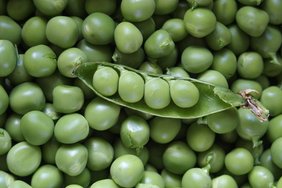
Pea protein concentrates and isolates are little used at the moment, partly because of their inherent, often characteristic, beany flavour. Their current primary use is the production of meat alternatives. Our project is investigating how certain flavour components develop in the early stage of the process chain and devising strategies to minimise undesirable flavours to the greatest possible extent.
The study focused on the characteristic "beany" flavour in pea protein extracts. Surprisingly, it turned out that not only lipoxygenase activity is an essential factor for flavour development, but that other processes during protein extraction also play a significant role.
Pea protein concentrates/isolates often have a typical inherent flavour, which is described as "beany". Studies suggest that enzymatically catalysed fat oxidation processes based on lipoxygenase (LOX) activity make a significant contribution to the typical aroma, as some fat oxidation products are identical to molecules that are considered to be a characteristic component of a "beany" aroma. However, little is known about the effects of the first steps in the processing chain (harvest, post-harvest, storage) on flavour formation. This study therefore investigated the significance of other factors in the process chain between cultivation and processing, in addition to LOX activity, which may favour the formation of a "beany" pea aroma. The samples were analysed by gas chromatography and evaluated on the basis of the relative concentrations of lead substances (including hexanal and nonanal).
The results indicate that neither the time of harvest nor a reduction/inactivation of the LOX before storage of the peas has a significant influence on the flavour situation. On the contrary, early shelling as well as thermal treatment of the peas before storage even led to increased concentrations of some of the analysed lead substances. While an increase in concentration with increasing storage temperature was confirmed, the vacuuming of samples compared to those with free oxygen access showed hardly any differences in the concentration of the lead compounds.
The results demonstrate that the elimination of LOX activity does not have the expected effect of reducing the development of undesirable flavour components. A substantial part of the development of the flavour components does not seem to be caused by the LOX activity or the formation of the flavour components or their precursors was already completed at the time of harvest. The removal of oxygen also did not have the expected effect. This supports the assumption that LOX activity in particular is not a relevant factor, at least during the phase between harvest and protein extraction. Rather, other processes that release bound flavour compounds or trigger secondary reactions (e.g. hydroperoxide decomposition to flavour-relevant molecules) appear to be important. During protein extraction, there is a massive accumulation of some undesirable flavour components, generally independent of the initial concentration of the flavours, so that the significance of the reduction of undesirable flavour formation prior to protein extraction can be questioned. It remains unclear at this stage whether and how flavour molecules are formed and/or released and/or enriched during extraction.
The study sheds new light on the development of "beany" flavour in peas and also provides new starting points for flavour-related research.
This text was translated with DeepL
In the Food 4.0 programme, the Swiss Academies of Arts and Sciences, under the leadership of the Swiss Academy of Engineering Sciences SATW, support innovative project ideas that are at the very beginning of development. In particular, the programme supports projects that demonstrate new perspectives for the successful development of the Swiss food system. The selected projects make an important contribution to solving the greatest challenges and address the topics of food waste, sustainability and health.